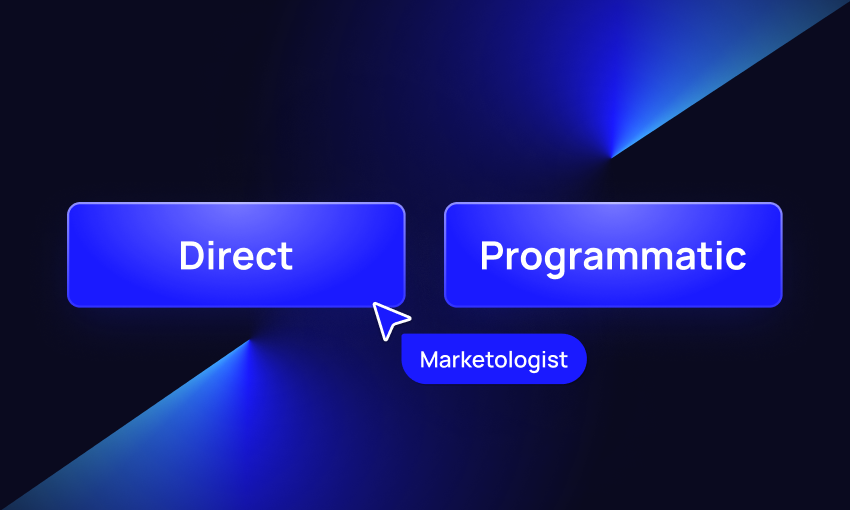Issue card


Digital advertising is about how you get your ads to the target audience, not just where they see them. Today, marketers can choose from two main options: direct and programmatic ad placement.
Both paths have their advantages. Direct buying gives you full control over your campaigns. At the same time, programmatic media buying allows you flexibility, helps you automate processes, and reaches highly targeted audiences.
In this article, we’ll analyze both options, compare programmatic ads and direct ads, and explore when each approach makes the most sense.
Direct media buying is the old-school handshake deal of digital ads. You, as the advertiser, go straight to a publisher and negotiate terms. You agree on where the ad will run, how long it will stay up, and what it’ll cost.
What you get:
What you don’t get is flexibility. Direct online advertising is less about targeting people and more about securing premium platforms. It’s perfect if you care about prestige placements for your digital ad or brand safety and don’t want to gamble on auctions.
Programmatic advertising changes the way you launch the ad campaign. Instead of long negotiations with publishers, you use a platform that connects to many websites. The system decides in real time which ad space to buy, based on your goals and audience data.
Here’s what it offers:
Programmatic technology isn’t equal to real-time bidding (RTB). RTB is one method, but there are also Programmatic Direct deals that let you secure guaranteed placements without the manual paperwork of traditional buying.
Programmatic isn’t one-size-fits-all. It comes with several options for an advertiser depending on how much control and exclusivity you want.
You reserve both the number of impressions and the price, just like with direct ad buying. The difference is that the process runs automatically through programmatic platforms, so there’s no extra paperwork. You get guaranteed ad inventory at fixed rates, but faster and easier.
It lets you get first access to a publisher’s ad inventory at a set CPM before it goes to auction. You don’t have to buy every impression, which makes it good for testing new placements or creatives. It gives some control, like direct buying, but with the flexibility of programmatic.
This an invite-only auction for premium ad inventory. It’s a safe way of buying and selling ads because you know the sites are high quality. PMPs help you get good reach while keeping control over where your ads show up.
It is the largest pool of ad inventory, which is bought and sold in real time through auctions. It’s cheap and can reach huge audiences, but you have less control over where ads appear. It can be helpful to combine RTB with PMPs or brand-safety tools to get quality.
The difference between direct and programmatic advertising shows up in price and how you pay. With direct buying, you pay a fixed rate for specific placements, like a homepage banner. You know exactly how many people will see your ad. This works well if your advertising goals need guaranteed visibility.
A programmatic approach uses ad exchanges and display networks. Prices can change in real time, but you can reach more people and adjust your budget when the campaign is already running.
In short, there’s no clear answer to which strategy is more cost-efficient. Direct advertising gives you control. Among the benefits of programmatic are speed, flexibility, and wider reach.
Now, let’s take a closer look, so you’ll know when to use direct and programmatic advertising.
As such, if you set it up correctly, use programmatic advertising to boost your marketing efficiency and speed. However, it’s important to be attentive to detail, as wrong settings can lead to wasted budget and harm your reputation.
Here’s a quick guide for matching your campaign goals with the right buying method:
Think of it like this: if you want full control of direct placements and your brand on a homepage for a launch, direct buying is the way to go. If you want to reach the right people across the web with targeted ads, programmatic advertising is better. In the advertising world, both methods have their place depending on your goals.
In practice, most advertisers don’t stick to one lane. They blend both. Here’s how that looks:
For example, a luxury brand might use direct buying for homepage banners on top fashion sites to build prestige, and use programmatic ads to reach people browsing designer clothes online.
Not always. Programmatic vs direct pricing depends on the advertising space and audience targeting. Some programmatic deals can be just as expensive as premium direct placements.
No. Programmatic includes RTB, but also options like Programmatic Guaranteed and Private Marketplaces. These give more control while still using automation.
Yes, programmatic deals let you ensure your ads reach the intended audience. This makes programmatic reliable for campaigns that need predictable impressions.
It’s better to implement direct ads when you want full control over where they appear. This approach is great for big, high-impact placements and works well alongside programmatic campaigns.
Your direct ad placements are priced based on the advertising space and how many people they can reach. Popular sites, prime positions, and longer campaigns usually cost more. You can negotiate rates with publishers to make sure your ad fits your budget and advertising goals.
It is a way to buy advertising automatically, which works across many advertising spaces, helping you reach the right audience fast. Unlike fixed-rate direct ad placements, RTB is flexible and changes based on demand and performance.

Share your email so we can send you latest Finup news & updates
You can unsubscribe at any time.